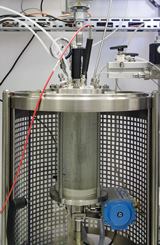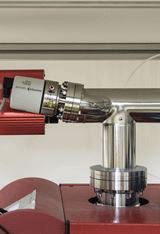

Reutilizing substances from biogas
Currently biogas is used mainly as an energy carrier for the production of heat and electricity. The energetic use of biogas is efficient when the heat is used sensibly all year round. However, this is not the case with all biogas plants. That is why for a long time there has been research into possibilities for reutilizing substances from biogas – which consists of approx. 40 to 75 percent methane, 25 to 55 percent carbon dioxide and 10 percent water – for example for the production of methanol. However, so far neither chemocatalytic nor biotechnological approaches have been very promising.
In the joint project “ECOX - Enzymatic-chemocatalytic oxidation cascades in the gas phase” in cooperation with the Leibniz Institute for Catalysis LIKAT in Rostock and the Martin Luther University in Halle, chemical and biotechnological reaction steps are combined in such a way that biogas can be converted as efficiently as possible to methanol and formic acid (Fig. 1). The aim here is also to lay the foundations for further processes for the conversion of gaseous substrates.
Combination of chemocatalytic and enzymatic conversion
The solution is to be found in the combination of a chemocatalytic conversion of methane to formaldehyde, which is being developed by the project partners, and the subsequent disproportionation of the formaldehyde to methanol and formic acid by means of a formaldehyde dismutase from Pseudomonas sp. in an enzyme reactor (Fig. 3). The enzyme technical step is being developed at the Fraunhofer IGB. The formic acid produced in the enzyme reactor can be used as a recoverable substance, returned to the catalytic process or converted to methyl formate. In this process, methyl formate is formed directly from methanol and formic acid in aqueous solution. If the formic acid is returned to the process, the resulting chemical analysis indicates 4 moles of methanol from 3 moles of methane, 1 mole of carbon dioxide and 2 moles of water. In this endothermic process the enthalpy of combustion for 4 moles of methanol is higher than that of the converted biogas with 3 moles of methane.
Enzyme reactor – immobilization of the dismutase
In the studies carried out so far we have succeeded in obtaining the formaldehyde dismutase from both the wild-type strain and from several recombinant strains as a storable enzyme with long-term stability. The enzyme was bound to various carrier materials. This resulted in enzyme activities of 0.0088 – 0.028 micromoles per minute per milligram of the carrier material. The catalytic half-life is 155 days. Enzymes were applied to the carrier with a defined spatial orientation by means of genetic modification, thus increasing the activity one hundred times.
Automated pilot plant for gas phase reactions
To develop the process technology, a fully automated test facility for gas phase reactions was designed and set up (Fig. 2) in which the temperature and the pressure can be precisely controlled. The concentrations of both the substrate formaldehyde and of the products is measured with an online mass spectrometer. By means of a special membrane module it is possible to simultaneously measure all the components of the reaction both in the aqueous phase and in the gas phase with a response time in the seconds range (Fig. 4). Initial tests show that with this method it is possible to provide a complete and reliable analysis of the dismutase reaction.
Outlook
The processing of the formaldehyde dismutase and its immobilization on carrier materials were completed successfully. The immobilized enzyme indicates very high enzyme activities. This and the fully functional test facility with online mass spectrometry are excellent preconditions for the development of an enzyme technical process.
The next step in the research project is the continuous production of methanol and formic acid with the immobilized formaldehyde dismutase in the test facility. In the subsequent project phase the enzyme technical process is coupled with the chemo-catalytic process to produce formaldehyde from biogas.
In addition to this, the technical process for the production of methanol and formic acid from biogas is a model for further enzyme technical processes with gaseous substrates in the gas phase and in combination with chemocatalytic reactions. It therefore represents an important step in the direction of recovering biogenic materials via gaseous intermediate products such as biogas or synthesis gas.
Funding
We would like to thank the German Federal Ministry of Education and Research (BMBF) for funding the project “ECOX – Enzymatic-chemocatalytic oxidation cascades in the gas phase”, promotional reference 031A168A.
Project partners
Leibniz Institute for Catalysis at the University of Rostock LIKAT, Rostock
Martin Luther University Halle-Wittenberg, Institute of Pharmacy, Working Group Processing of Biotechnical Products, Halle
 Fraunhofer Institute for Interfacial Engineering and Biotechnology IGB
Fraunhofer Institute for Interfacial Engineering and Biotechnology IGB